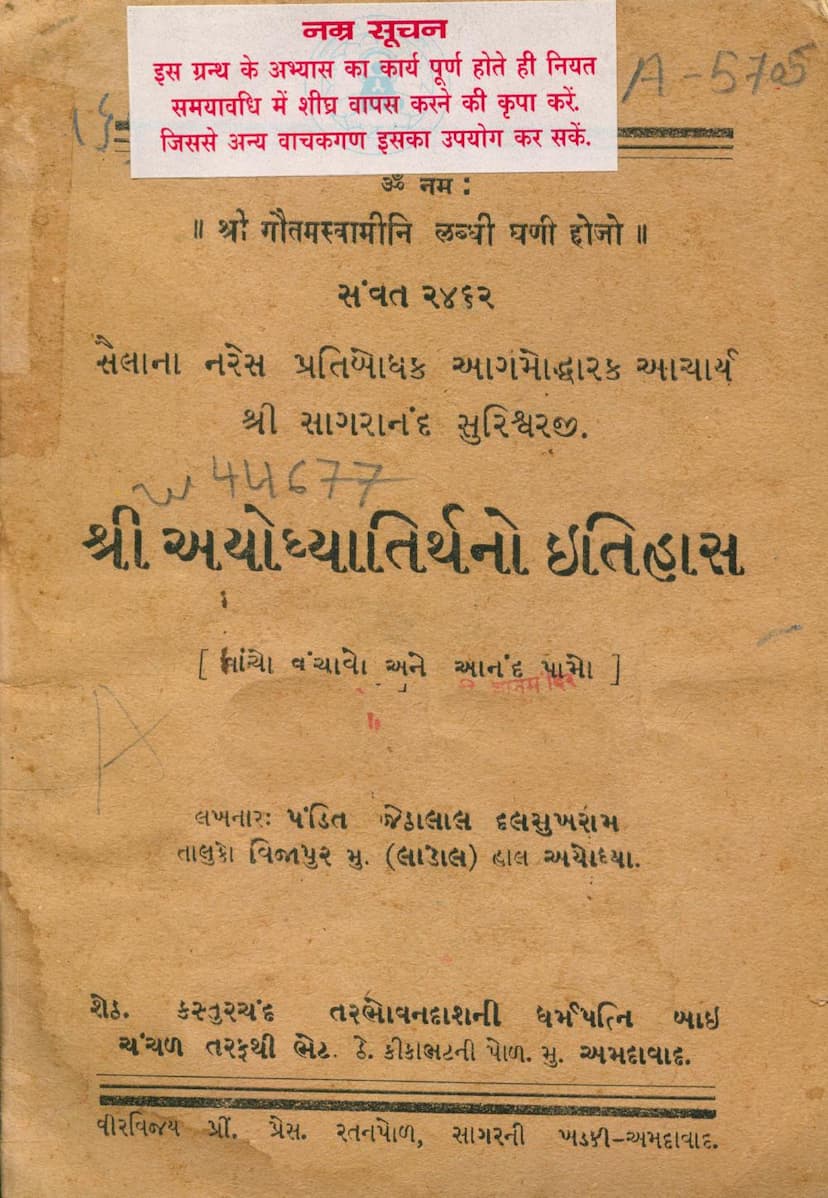Ayodhya Tirthno Itihas
Added to library: September 1, 2025

Summary
Here's a comprehensive summary of the Jain text "Ayodhya Tirthno Itihas" by Jethalal Dalsukhram, based on the provided pages:
Book Title: Ayodhya Tirthno Itihas (History of Ayodhya Pilgrimage) Author: Jethalal Dalsukhram Publisher: Chanchalben Kasturchand Sheth
Overall Purpose: The book is a historical account of the Jain pilgrimage site of Ayodhya, focusing on its significance within Jainism, its connection to the first Tirthankar Bhagwan Rishabhdev (Adinath), and the efforts made for its preservation and renovation. It also details the donations and contributions made for the development of the pilgrimage site.
Key Themes and Content:
-
Ayodhya as a Sacred Jain Site: The text emphasizes Ayodhya's profound importance in Jainism, being the birthplace of Bhagwan Rishabhdev, the first Tirthankar. It highlights that a single visit and remembrance of Adinath's birthplace yield greater merit than visiting sixty-eight other sacred places mentioned in Hinduism.
-
Connection to Rishabhdev and Jainism's Origins: Ayodhya, also known by its ancient names Vinita Nagari and Indrapuri, is described as the city where Rishabhdev was born. He is credited with establishing the societal structure, including the four Varnas (Brahmin, Kshatriya, Vaishya, Shudra), and initiating the Jain Arya civilization. The text mentions the establishment of the Chaturvidh Sangh (four-fold community) and Ganadharas by Rishabhdev for the proper functioning of the Jain order.
-
Historical Figures and Events Associated with Ayodhya:
- Bhagwan Rishabhdev: Born in Ayodhya, he initiated his spiritual journey and established the Jain order.
- Bharat Chakravarti: Rishabhdev's eldest son, who was appointed ruler of Vinita Nagari and led many of his brothers and sisters (like Brahmi and Sundari) to accept Jainism. Bharat Chakravarti is also credited with the first renovation of the Siddha Kshetra Shatrunjay and the construction of a golden temple there.
- Pundarik Swami: Bharat Chakravarti's son, who became the first Ganadhara.
- Other Tirthankar and Prominent Jains: The text mentions that Ayodhya is significant for the Kalyanaks (auspicious events like birth, initiation, omniscience) of several Tirthankars:
- Bhagwan Rishabhdev (3 Kalyanaks: initiation, birth, descent)
- Bhagwan Ajitnath (4 Kalyanaks: initiation, birth, omniscience, descent)
- Bhagwan Abhinandan (4 Kalyanaks: initiation, birth, omniscience, descent)
- Bhagwan Sumatinath (4 Kalyanaks: initiation, birth, omniscience, descent)
- Bhagwan Anantnath (4 Kalyanaks: initiation, birth, omniscience, descent) This accounts for a total of 19 Kalyanaks occurring in Ayodhya.
- Illustrious Kings and Personalities: The text lists numerous historical figures, including kings like Chakravarti Bharat, King Shreyans, King Sagar, King Jitshatru, King Harishchandra, King Dileep, King Raghu, King Dasharath, and Bhagwan Mahavir Swami (as the ninth Ganadhara), who were either born in or associated with Ayodhya and its lineage. It also mentions prominent women like Marudevā (mother of Rishabhdev), Sunanda, Sumangala, Vijayā, Siddhartha, Mangalā, Supasā, Sunandā, Rishabh Nandinī, Brahmi, Sundari, Tāramati, Kausalya, and Sītā.
-
Historical Transformations and Challenges to the Site:
- Ayodhya faced numerous invasions and hardships from various foreign groups like Shakas, Hunas, Scythians, Megalians, Greeks, and Iranians.
- During periods of decline, the Jain faith faced internal divisions and external pressures. The text mentions the rise of other religious orders and the impact of societal changes, leading to some Jains converting to other faiths.
- The site suffered neglect and deterioration over time, reaching a state of disrepair.
-
Renovation and Restoration Efforts:
- Emperor Samprati: Played a significant role in the restoration of the Tirtha. He was a devout Jain king who built numerous temples and supported the faith.
- Emperor Chandragupta Vikramaditya: The text credits him with the re-establishment and restoration of Ayodhya.
- Acharya Shri Hiravijayasuri: During Emperor Akbar's reign, he secured assurances for the protection of Jain pilgrimage sites, including Ayodhya.
- Acharya Shri Kushalachandrasuriji and Hukumichandji: In Vikram Samvat 1401 (1871 of the Veer Nirvana Era), under their guidance, Hukumichandji of Jaipur undertook the restoration of the Ayodhya Tirtha and established the idol of Bhagwan Ajitnath with Charan Padukas (footprints).
- Acharya Shri Sagarānand Surishwarji: In Vikram Samvat 1983, he visited Ayodhya, was deeply moved by its dilapidated state, and initiated efforts for its restoration.
- Bai Vijkuvar: A devout follower from Ahmedabad, who, inspired by her spiritual experiences and guided by Acharya Sagarānand Surishwarji, took a strong resolve to restore the Tirtha, even pledging her life for the cause. She became a pivotal figure in the restoration efforts.
-
Development and Present State:
- The book details the reconstruction and development of the Tirtha, including:
- The construction of a magnificent temple housing the Kalyanaks of the five Tirthankars.
- The construction of a large Dharamshala (guesthouse) with residential rooms, kitchens, and other facilities for pilgrims.
- The establishment of a motor house with living quarters for drivers.
- The construction of a protective wall.
- The text lists numerous individuals and families who contributed financially or through specific donations for the various parts of the temple and facilities. These include donations for the construction of specific Kalyanaka shrines, idols, seats (singhasan), depictions of events (drishtanta patiya), and architectural elements.
- The book details the reconstruction and development of the Tirtha, including:
-
Call to Action and Spiritual Merit:
- The book concludes with an appeal to the Jain community to actively participate in the preservation and maintenance of such significant pilgrimage sites.
- It emphasizes the immense spiritual merit (punya) gained from worshipping, building, renovating, and protecting Jain temples and holy places, citing scriptural references.
- It warns against the possibility of losing control of these sites to others if not properly maintained and managed.
In essence, "Ayodhya Tirthno Itihas" is a detailed chronicle of a significant Jain pilgrimage site, tracing its historical, spiritual, and developmental journey, highlighting the efforts of saints, kings, and devoted followers in preserving its legacy.